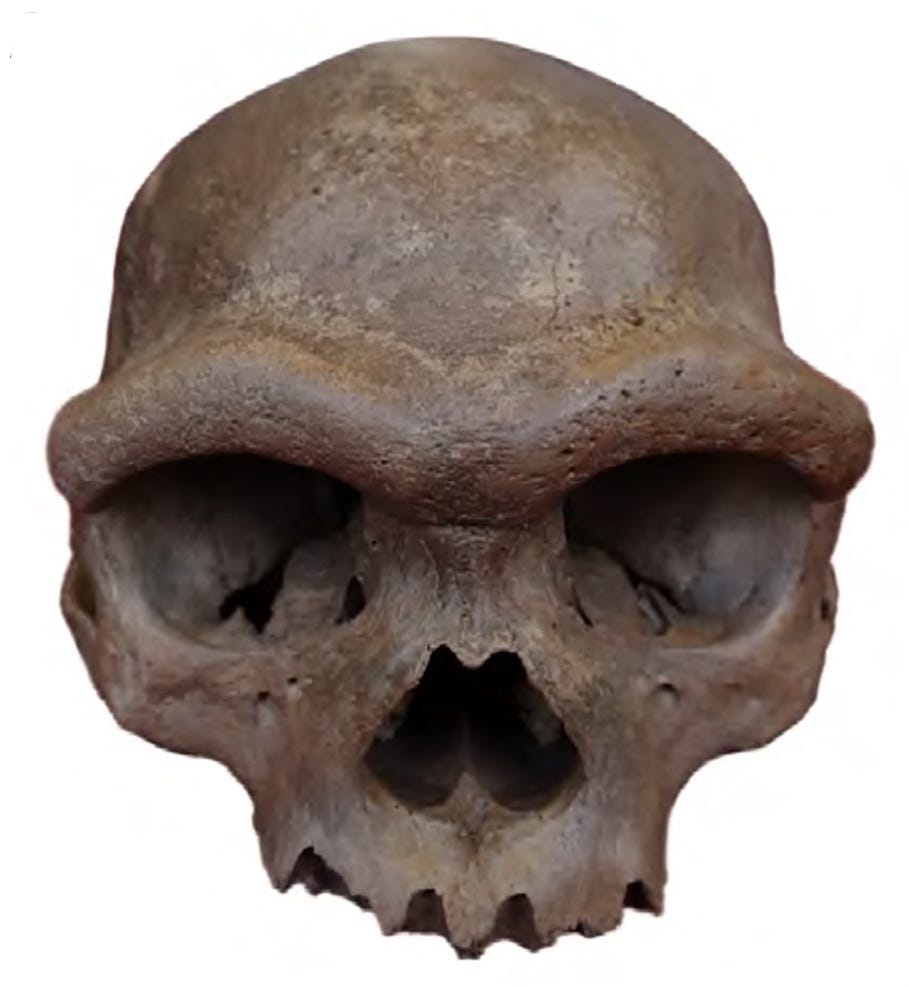Human Evolution: A new face for the Denisovans?
A cranium found in China more than 90 years ago gives up its molecular secrets.
As some readers of “Words for the Wise” know, I was the Paris correspondent for the journal Science for 25 years. For the last 15 or so of those years, my reporting focused almost entirely on archaeology and anthropology, including human evolution (I managed to publish one book during that time, about Neolithic Çatalhöyük and the origins of civilization, which began as a Science story.)
In the years since I have tried to keep up with developments in human evolution, and I hope to publish more often on that topic here in this space.
Last week saw the publication of two papers, one in Cell and one in Science, that—if their conclusions are correct—would finally give a face to the mysterious Denisovans, a branch of the human evolutionary tree that apparently shares a common ancestor with both modern humans (Homo sapiens) and the Neanderthals. (That common ancestor is widely believed by scientists to have lived in Africa.)
Until now, the Denisovans, named after the cave in Siberia where their DNA was first identified, have been known almost entirely from the genetic traces they left behind. The few fossil fragments—such as a piece of a pinkie bone in which Denisovan DNA was first identified by Qiaomei Fu and her colleagues about 15 years ago—did not give any clear picture of what these early humans looked like.
Qiaomei Fu, who is now at the Institute of Vertebrate Paleontology and Paleoanthropology in Beijing, was the lead author on both of the papers, which reported analyses on a skull found at a construction site in the Chinese city of Harbin back in 1933. But scientists did not begun studying the so-called Harbin skull until 2018; a few years later, they named it Homo longi, after the region where it was found. The skull is thought to be at least 146,000 years old, which would make it contemporaneous with the earliest known specimens of Homo sapiens.
(Science writer Carl Zimmer had a good summary of the history of research on the Harbin skull in the New York Times last week, which I will comment on in a moment.)
The conclusion that the Harbin skull belonged to a Denisovan came from an analysis of its mitochondrial DNA (in the Cell paper) and its proteins (in the Science paper), a good cross check on the claims the authors are making. The mitochondrial DNA was found in the dental calculus of the cranium, an example of the kind of technical advances scientists have made in the ancient DNA field.
But there still seems to be some debate about the pedigree of the Harbin skull, which is reflected very obliquely at the very end of Carl Zimmer’s Times article. Carl is pretty sophisticated about such things, which leads me to suspect that an editor chopped up his concluding paragraphs, thus compromising reader understanding of the nuances and debates in the field. Thus he quotes John Hawks, a paleoanthropologist at the University of Wisconsin at Madison, as agreeing that the Harbin skull is a Denisovan, but that they, modern humans, and Neanderthals, “are all Homo sapiens.”
This reflects the views of Hawks, a well-known “multiregionalist,” that modern humans evolved separately in different parts of the world but that interbreeding led to all these family trees coalescing into one species.
On the other hand, Zimmer quotes Chris Stringer, a paleoanthropologist at the Natural History Museum in London, as saying “Homo longi is the appropriate species name for this group.” Stringer is closely associated with the anti-multiregionalist position sometimes referred to as the Out of Africa hypothesis. In recent years, many scientists have come to think that both views are correct in some ways, especially as evidence for interbreeding between different hominid groups has mounted.
I’ve known Chris Stringer for more than a quarter of a century, so I asked him to comment on all of this. Here is what he had to say. I hope readers find it of interest, and will forgive me for not asking Hawks to comment as well—I think his position is pretty clear and consistent with his well known views.
Meanwhile, I hope to post more often on human evolution and related topics going forward.
Chris Stringer writes:
“These two papers [Science and Cell] providing molecular data from the Harbin cranium are potentially very important, although it will require experts on ancient DNA and proteomes to give a fuller assessment of the results. I have been collaborating with Chinese scientists on new morphological analyses of human fossils, including Harbin, and combined with our studies, this work makes it increasingly likely that Harbin is the most complete fossil of a Denisovan found so far, and that Homo longi is the appropriate species name for this group. Another name Homo juluensis was recently created to include the Denisovans but not Harbin, so that name is unlikely to be appropriate for either of them. Our ongoing analyses provide clarity about the so-called ‘muddle in the middle’ by suggesting that most of the large-brained humans from the last 800,000 years can be sorted into one or other of the following groups/species: Asian erectus, heidelbergensis, Neanderthals, sapiens and Denisovans/longi. There is certainly much more to come from extractions of ancient DNA and proteomes from the human fossils. However, morphological studies will remain crucial for testing relationships, particularly as most of the fossils do not have, and will probably never have, ancient DNA or rich proteomic data - also, if we want to know what people such as the Denisovans actually looked like!”
**********************************************************************************************************
To share this post, or to share “Words for the Wise,” please click on these links.




